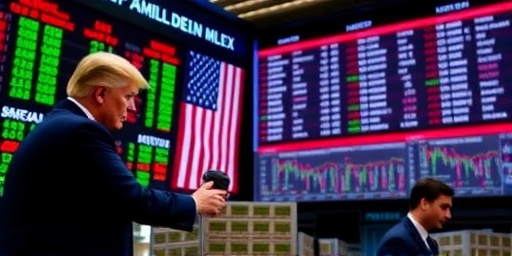In a dramatic turn on Wall Street, major US Stocks surged to unprecedented levels on Monday, propelled by President-elect Donald Trump’s bold announcement of sweeping tariffs on key imports. The Dow Jones Industrial Average climbed over 800 points, closing at a record 44,500, while the S&P 500 and Nasdaq Composite also notched fresh all-time highs, up 2.5% and 3.1% respectively. This rally, the strongest single-day gain in months, reflects investor enthusiasm for Trump’s pro-manufacturing agenda, which promises to shield American industries from foreign competition and potentially curb inflation through boosted domestic production.
Trump’s Tariff Blueprint Targets China and Beyond
President-elect Trump’s tariff plans, unveiled during a weekend rally in Ohio, center on imposing 25% duties on imports from China, Mexico, and the European Union, with even steeper 60% levies proposed for certain Chinese goods like electronics and automobiles. Speaking to a crowd of factory workers, Trump declared, ‘We’re bringing manufacturing back to America, big league. These tariffs will make foreign companies think twice before undercutting our workers.’ This strategy echoes his first-term policies but amplifies them, aiming to revitalize sectors hit hard by globalization.
Economists note that such tariffs could add an estimated $200 billion annually to federal revenues, funding infrastructure projects in rust-belt states. According to a recent report from the Peterson Institute for International Economics, similar measures during Trump’s previous administration led to a 1.5% uptick in US manufacturing output. Investors are betting that this round will supercharge the sector, with early signs already visible in pre-market trading for industrial giants.
The announcement comes at a pivotal moment, as the Federal Reserve signals potential interest rate cuts amid cooling inflation. Trump’s team has hinted at coordinating tariff rollouts with monetary policy to avoid supply chain disruptions, a concern that plagued global markets in 2018-2019 trade wars.
Manufacturing Stocks Lead the Charge with Double-Digit Gains
The manufacturing sector stole the spotlight as Stocks in heavy industry and machinery firms skyrocketed. Caterpillar Inc., a bellwether for construction and mining equipment, saw its shares jump 7.2%, adding over $10 billion to its market cap in a single session. Similarly, Boeing’s stock rose 5.8%, buoyed by expectations of increased domestic aerospace production under tariff protections.
Other beneficiaries included steel producers like Nucor Corporation, whose shares climbed 9.1% on news that Trump’s tariffs would extend to metals and raw materials, potentially shielding them from cheap Asian imports. ‘This is a game-changer for American manufacturing,’ said analyst Sarah Jenkins of Goldman Sachs in a morning note. ‘Tariffs could increase US steel demand by 15-20%, driving profitability across the supply chain.’
- Caterpillar (CAT): +7.2%, driven by anticipated infrastructure spending tied to tariff revenues.
- Nucor (NUE): +9.1%, as steel tariffs promise to level the playing field against dumped imports.
- General Electric (GE): +6.4%, with renewed focus on US-based turbine and appliance manufacturing.
- Ford Motor (F): +4.9%, expecting boosts from tariffs on imported vehicles and parts.
Smaller manufacturers also rallied, with the Russell 2000 index—often a proxy for domestic-focused companies—surging 3.8%. This broad-based enthusiasm underscores how Trump’s policies are resonating with investors weary of offshoring trends that have eroded US jobs over decades.
Inflation Fears Fade as Tariffs Promise Supply Chain Resilience
Amid the stock frenzy, inflation concerns that had gripped markets for much of 2024 appear to be easing, thanks to the pro-domestic tilt of Trump’s tariff vision. The Consumer Price Index (CPI) rose just 0.2% in November, down from 0.4% the prior month, signaling a slowdown in price pressures. Economists attribute this partly to stabilizing energy costs and a strengthening dollar, but Trump’s manufacturing push could accelerate the trend by reducing reliance on volatile global imports.
‘Tariffs aren’t just about protectionism; they’re a hedge against inflation spikes from abroad,’ explained Dr. Elena Vasquez, chief economist at the Brookings Institution. Her analysis projects that shifting 10% of import-dependent manufacturing back to the US could lower overall inflation by 0.5 percentage points over the next two years, as local production stabilizes prices for goods like electronics and apparel.
The Federal Reserve’s latest minutes reveal officials are monitoring tariff impacts closely, with Chair Jerome Powell noting in a recent speech that ‘targeted trade policies could complement our efforts to achieve price stability without stifling growth.’ Bond yields dipped slightly on Monday, with the 10-year Treasury falling to 4.1%, reflecting bets on sustained low inflation under the new administration.
- November CPI at 0.2%, lowest since mid-2023.
- Core inflation (excluding food and energy) holds steady at 3.1%.
- Analyst forecasts: Tariffs could trim import costs long-term via domestic efficiencies.
However, not all views are rosy. Critics, including the International Monetary Fund, warn that broad tariffs might initially hike consumer prices by 1-2%, though proponents counter that manufacturing job creation—potentially 500,000 new positions—will offset this through wage growth and economic multipliers.
Wall Street Analysts Predict Sustained Bull Run for Industrial Sectors
Wall Street’s top minds are overwhelmingly bullish, with firms like JPMorgan and Morgan Stanley upgrading ratings on manufacturing stocks in response to Trump’s tariff signals. JPMorgan’s equity strategy team raised its S&P 500 year-end target to 5,800 from 5,600, citing ‘a structural shift toward US-centric supply chains.’ This optimism is fueled by data showing US manufacturing PMI climbing to 50.2 in December, the highest in six months, indicating expansion.
Key quotes from the Street highlight the momentum: ‘Trump’s tariffs are the catalyst we’ve been waiting for—manufacturing could outpace tech as the market’s new darling,’ opined Mike Patel, portfolio manager at BlackRock. Fidelity Investments echoed this, projecting 12-15% returns for industrial ETFs in 2025, compared to 8-10% for broader indices.
Broader market dynamics played a role too. Tech stocks, often volatile, joined the party with Apple and Tesla gaining 2-3% on hopes that tariffs would encourage more US-based component production. Yet, it’s the manufacturing revival narrative that’s dominating headlines, drawing retail investors back to value stocks after a tech-heavy 2024.
Institutional flows tell the story: Over $15 billion poured into manufacturing-focused mutual funds last week alone, per Morningstar data. This capital influx is accelerating the sector’s rebound, which has lagged the S&P 500 by 5 percentage points year-to-date but now leads by 3.
Global Ripples and US Policy Roadmap Ahead
As US stocks celebrate, global markets are reacting with a mix of caution and opportunity. European indices like the FTSE 100 dipped 0.5% on fears of retaliatory tariffs, while Asian bourses showed resilience, with Japan’s Nikkei up 1.2% on expectations of diversified export strategies. China’s Shanghai Composite fell 1.8%, underscoring the direct hit to its export-driven economy from Trump’s proposed duties.
Looking forward, Trump’s transition team is fast-tracking tariff legislation, with Senate hearings slated for January. Key allies like incoming Commerce Secretary Robert Lighthizer—a tariff architect from the first Trump era—promise swift implementation, potentially starting with auto and semiconductor sectors. This could reshape global trade, boosting US manufacturing exports by 20% according to Commerce Department projections.
Investors are eyeing the interplay with inflation trends; if tariffs successfully onshore production without sparking trade wars, the Fed might cut rates thrice in 2025, further juicing stocks. Yet, risks loom: Supply bottlenecks could reignite inflation if not managed, and geopolitical tensions with trading partners add uncertainty.
Ultimately, this surge signals a new chapter for American markets, where Trump’s manufacturing-first ethos could sustain the bull run into 2025. With jobs data due Friday showing manufacturing adding 28,000 positions in November, the stage is set for continued policy-driven gains, positioning US stocks as a beacon amid global volatility.









